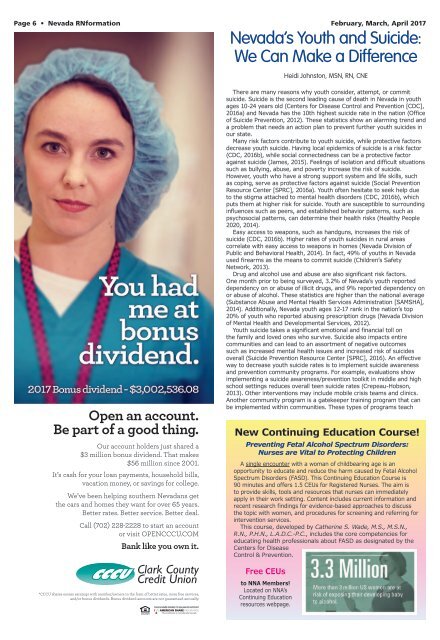Nevada RNFormation - February 2017
You also want an ePaper? Increase the reach of your titles
YUMPU automatically turns print PDFs into web optimized ePapers that Google loves.
Page 6 • <strong>Nevada</strong> RNformation <strong>February</strong>, March, April <strong>2017</strong><br />
<strong>Nevada</strong>’s Youth and Suicide:<br />
We Can Make a Difference<br />
Heidi Johnston, MSN, RN, CNE<br />
There are many reasons why youth consider, attempt, or commit<br />
suicide. Suicide is the second leading cause of death in <strong>Nevada</strong> in youth<br />
ages 10-24 years old (Centers for Disease Control and Prevention [CDC],<br />
2016a) and <strong>Nevada</strong> has the 10th highest suicide rate in the nation (Office<br />
of Suicide Prevention, 2012). These statistics show an alarming trend and<br />
a problem that needs an action plan to prevent further youth suicides in<br />
our state.<br />
Many risk factors contribute to youth suicide, while protective factors<br />
decrease youth suicide. Having local epidemics of suicide is a risk factor<br />
(CDC, 2016b), while social connectedness can be a protective factor<br />
against suicide (James, 2015). Feelings of isolation and difficult situations<br />
such as bullying, abuse, and poverty increase the risk of suicide.<br />
However, youth who have a strong support system and life skills, such<br />
as coping, serve as protective factors against suicide (Social Prevention<br />
Resource Center [SPRC], 2016a). Youth often hesitate to seek help due<br />
to the stigma attached to mental health disorders (CDC, 2016b), which<br />
puts them at higher risk for suicide. Youth are susceptible to surrounding<br />
influences such as peers, and established behavior patterns, such as<br />
psychosocial patterns, can determine their health risks (Healthy People<br />
2020, 2014).<br />
Easy access to weapons, such as handguns, increases the risk of<br />
suicide (CDC, 2016b). Higher rates of youth suicides in rural areas<br />
correlate with easy access to weapons in homes (<strong>Nevada</strong> Division of<br />
Public and Behavioral Health, 2014). In fact, 49% of youths in <strong>Nevada</strong><br />
used firearms as the means to commit suicide (Children’s Safety<br />
Network, 2013).<br />
Drug and alcohol use and abuse are also significant risk factors.<br />
One month prior to being surveyed, 3.2% of <strong>Nevada</strong>’s youth reported<br />
dependency on or abuse of illicit drugs, and 9% reported dependency on<br />
or abuse of alcohol. These statistics are higher than the national average<br />
(Substance Abuse and Mental Health Services Administration [SAMSHA],<br />
2014). Additionally, <strong>Nevada</strong> youth ages 12-17 rank in the nation’s top<br />
20% of youth who reported abusing prescription drugs (<strong>Nevada</strong> Division<br />
of Mental Health and Developmental Services, 2012).<br />
Youth suicide takes a significant emotional and financial toll on<br />
the family and loved ones who survive. Suicide also impacts entire<br />
communities and can lead to an assortment of negative outcomes<br />
such as increased mental health issues and increased risk of suicides<br />
overall (Suicide Prevention Resource Center [SPRC], 2016). An effective<br />
way to decrease youth suicide rates is to implement suicide awareness<br />
and prevention community programs. For example, evaluations show<br />
implementing a suicide awareness/prevention toolkit in middle and high<br />
school settings reduces overall teen suicide rates (Crepeau-Hobson,<br />
2013). Other interventions may include mobile crisis teams and clinics.<br />
Another community program is a gatekeeper training program that can<br />
be implemented within communities. These types of programs teach<br />
New Continuing Education Course!<br />
Preventing Fetal Alcohol Spectrum Disorders:<br />
Nurses are Vital to Protecting Children<br />
A single encounter with a woman of childbearing age is an<br />
opportunity to educate and reduce the harm caused by Fetal Alcohol<br />
Spectrum Disorders (FASD). This Continuing Education Course is<br />
90 minutes and offers 1.5 CEUs for Registered Nurses. The aim is<br />
to provide skills, tools and resources that nurses can immediately<br />
apply in their work setting. Content includes current information and<br />
recent research findings for evidence-based approaches to discuss<br />
the topic with women, and procedures for screening and referring for<br />
intervention services.<br />
This course, developed by Catherine S. Wade, M.S., M.S.N.,<br />
R.N., P.H.N., L.A.D.C.-P.C., includes the core competencies for<br />
educating health professionals about FASD as designated by the<br />
Centers for Disease<br />
Control & Prevention.<br />
Free CEUs<br />
to NNA Members!<br />
Located on NNA’s<br />
Continuing Education<br />
resources webpage.

















